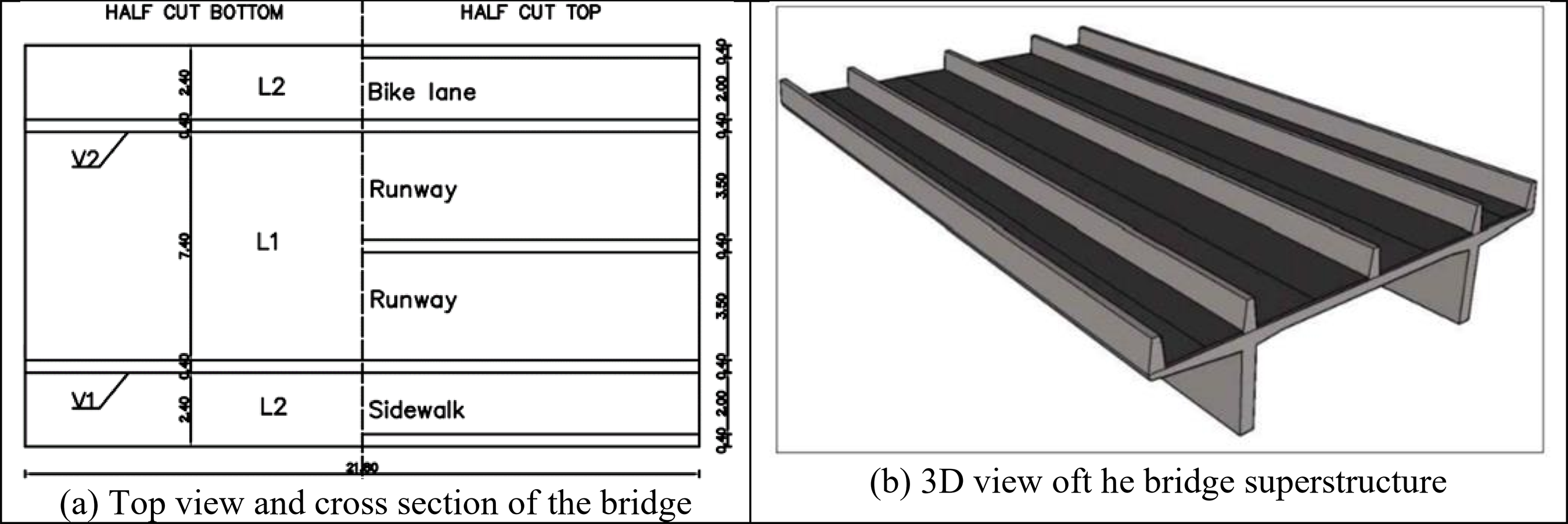Abstract
Climate change presents a challenge for the construction industry to develop modern building materials that must not only meet functional performance criteria but also reduce the environmental impact associated with their production. In this context, the primary objective of this study is to apply the Life Cycle Assessment (LCA) technique to the superstructures of steel/concrete composite bridges and reinforced concrete bridges, aiming to identify potential environmental impacts and opportunities for enhancing environmental performance, especially concerning the use of materials and services. The study was based on the ISO 14040 and ISO 14044 guidelines and employed the International Reference Life Cycle Data System (ILCD); Evah OzLCI2019 database; data collected by the Construction Environmental Performance Information System (SIDAC); OpenLCA software version 2.0, and the ReCiPe 2016 Midpoint (H) method. The results indicated that, in general, reinforced concrete bridges had a lower environmental impact compared to composite bridges, with the exception of some indicators such as freshwater eutrophication and ionizing radiation. Therefore, the use of steel in composite bridges has proven to be a significant source of environmental impact, especially when used as a substitute for concrete.
Keywords
Life Cycle Assessment (LCA); Bridges; Environmental impact

 Environmental impact of steel/concrete composite bridges and reinforced concrete bridges: a comparative analysis through Life Cycle Assessment
Environmental impact of steel/concrete composite bridges and reinforced concrete bridges: a comparative analysis through Life Cycle Assessment Thumbnail
Thumbnail
 Thumbnail
Thumbnail
 Thumbnail
Thumbnail
 Thumbnail
Thumbnail
 Thumbnail
Thumbnail
 Thumbnail
Thumbnail
 Thumbnail
Thumbnail
 Thumbnail
Thumbnail



 Note: FPMF-Fine Particulate Matter Formation; FRS-Fossil Resource Scarcity; FE-Freshwater Ecotoxicity; FEU-Freshwater Eutrophication; GW-Global Warming; HCT-Human Carcinogenic toxicity; HNCT-Human Non-Carcinogenic Toxicity; IR-Ionizing Radiation; LU-Land Use; ME-Marine Ecotoxicity; MEU-Marine Eutrophi-cation; MRS-Mineral Resource Scarcity; OFHH-Ozone Formation, Human Health; OFTE-Ozone Formation, Terrestrial Ecosystems; SOD-Stratospheric Ozone Depletion; TA-Terrestrial Acidification; TE-Terrestrial Ecotoxicity; WC-Water Consumption.
Note: FPMF-Fine Particulate Matter Formation; FRS-Fossil Resource Scarcity; FE-Freshwater Ecotoxicity; FEU-Freshwater Eutrophication; GW-Global Warming; HCT-Human Carcinogenic toxicity; HNCT-Human Non-Carcinogenic Toxicity; IR-Ionizing Radiation; LU-Land Use; ME-Marine Ecotoxicity; MEU-Marine Eutrophi-cation; MRS-Mineral Resource Scarcity; OFHH-Ozone Formation, Human Health; OFTE-Ozone Formation, Terrestrial Ecosystems; SOD-Stratospheric Ozone Depletion; TA-Terrestrial Acidification; TE-Terrestrial Ecotoxicity; WC-Water Consumption.
 Note: (a) PCA; (b) PCA-50%; (c) PCA-100%. FPMF-Fine Particulate Matter Formation; FRS-Fossil Resource Scarcity; FE-Freshwater Ecotoxicity; FEU-Freshwater Eutrophication; GW-Global Warming; HCT-Human Carcinogenic toxicity; HNCT-Human Non-Carcinogenic Toxicity; IR-Ionizing Radiation; LU-Land Use; ME-Marine Ecotoxicity; MEU-Marine Eutrophi-cation; MRS-Mineral Resource Scarcity; OFHH-Ozone Formation, Human Health; OFTE-Ozone Formation, Terrestrial Ecosystems; SOD-Stratospheric Ozone Depletion; TA-Terrestrial Acidification; TE-Terrestrial Ecotoxicity; WC-Water Consumption.
Note: (a) PCA; (b) PCA-50%; (c) PCA-100%. FPMF-Fine Particulate Matter Formation; FRS-Fossil Resource Scarcity; FE-Freshwater Ecotoxicity; FEU-Freshwater Eutrophication; GW-Global Warming; HCT-Human Carcinogenic toxicity; HNCT-Human Non-Carcinogenic Toxicity; IR-Ionizing Radiation; LU-Land Use; ME-Marine Ecotoxicity; MEU-Marine Eutrophi-cation; MRS-Mineral Resource Scarcity; OFHH-Ozone Formation, Human Health; OFTE-Ozone Formation, Terrestrial Ecosystems; SOD-Stratospheric Ozone Depletion; TA-Terrestrial Acidification; TE-Terrestrial Ecotoxicity; WC-Water Consumption.
 Note: (a) PMA; (b) PMA-50%; (c) PMA-100%. FPMF-Fine Particulate Matter Formation; FRS-Fossil Resource Scarcity; FE-Freshwater Ecotoxicity; FEU-Freshwater Eutrophication; GW-Global Warming; HCT-Human Carcinogenic toxicity; HNCT-Human Non-Carcinogenic Toxicity; IR-Ionizing Radiation; LU-Land Use; ME-Marine Ecotoxicity; MEU-Marine Eutrophi-cation; MRS-Mineral Resource Scarcity; OFHH-Ozone Formation, Human Health; OFTE-Ozone Formation, Terrestrial Ecosystems; SOD-Stratospheric Ozone Depletion; TA-Terrestrial Acidification; TE-Terrestrial Ecotoxicity; WC-Water Consumption.
Note: (a) PMA; (b) PMA-50%; (c) PMA-100%. FPMF-Fine Particulate Matter Formation; FRS-Fossil Resource Scarcity; FE-Freshwater Ecotoxicity; FEU-Freshwater Eutrophication; GW-Global Warming; HCT-Human Carcinogenic toxicity; HNCT-Human Non-Carcinogenic Toxicity; IR-Ionizing Radiation; LU-Land Use; ME-Marine Ecotoxicity; MEU-Marine Eutrophi-cation; MRS-Mineral Resource Scarcity; OFHH-Ozone Formation, Human Health; OFTE-Ozone Formation, Terrestrial Ecosystems; SOD-Stratospheric Ozone Depletion; TA-Terrestrial Acidification; TE-Terrestrial Ecotoxicity; WC-Water Consumption.
 Note: FPMF-Fine Particulate Matter Formation; FRS-Fossil Resource Scarcity; FE-Freshwater Ecotoxicity; FEU-Freshwater Eutrophication; GW-Global Warming; HCT-Human Carcinogenic toxicity; HNCT-Human Non-Carcinogenic Toxicity; IR-Ionizing Radiation; LU-Land Use; ME-Marine Ecotoxicity; MEU-Marine Eutrophi-cation; MRS-Mineral Resource Scarcity; OFHH-Ozone Formation, Human Health; OFTE-Ozone Formation, Terrestrial Ecosystems; SOD-Stratospheric Ozone Depletion; TA-Terrestrial Acidification; TE-Terrestrial Ecotoxicity; WC-Water Consumption.
Note: FPMF-Fine Particulate Matter Formation; FRS-Fossil Resource Scarcity; FE-Freshwater Ecotoxicity; FEU-Freshwater Eutrophication; GW-Global Warming; HCT-Human Carcinogenic toxicity; HNCT-Human Non-Carcinogenic Toxicity; IR-Ionizing Radiation; LU-Land Use; ME-Marine Ecotoxicity; MEU-Marine Eutrophi-cation; MRS-Mineral Resource Scarcity; OFHH-Ozone Formation, Human Health; OFTE-Ozone Formation, Terrestrial Ecosystems; SOD-Stratospheric Ozone Depletion; TA-Terrestrial Acidification; TE-Terrestrial Ecotoxicity; WC-Water Consumption.
